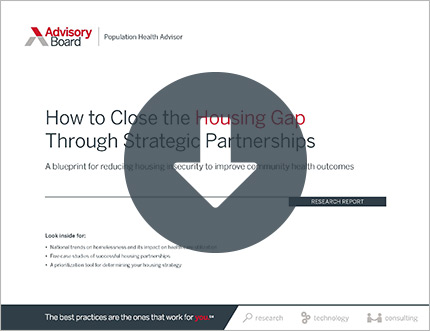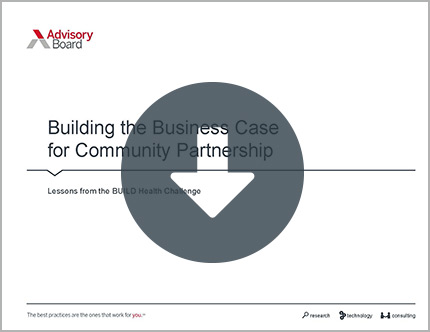Auto logout in seconds.
Continue LogoutHealth systems increasingly are looking beyond the hospital walls to invest in their local economies in hope of addressing social determinants of health, Kate King reports for the Wall Street Journal.
June 13 webcon: The business case for investment in a mobile care delivery strategy
Impetus for change
One driver behind the shift came from the Affordable Care Act, which requires tax-exempt hospitals every three years to conduct a "community health needs" assessment to gauge how local issues, such as access and racial inequity, influence health, King writes. Another driver is the health care system's shift to value-based care models that focus on reducing health care costs.
In addition, health care institutions are facing calls from local leaders to contribute more to their communities, according to Erika Poethig, VP for policy and chief innovation officer at the Urban Institute. "A lot of the valuable [hospital] land is not taxable, but the city is providing services to those institutions: fire, police, garbage pickup, street repair," she said.
How one health system is investing locally
Across the country, health systems are answering those calls, King writes.
In Newark, New Jersey, RWJBarnabas Health's Newark Beth Israel Medical Center—which treats a patient population that has high rates of poverty and unemployment—has sought to hire and purchase goods locally to drive the local economy.
In 2016, the medical center began working with Khalif Thomas, an HVAC mechanic at the hospital who has a side business making novelty socks called Rock Ya Sock.
"I don't think there's another industry that would purchase more socks than the health care industry," Thomas said. He has sold 83,000 socks to the hospital since late 2016, and RWJBarnabas executives want to see Rock Ya Sock start suppling socks to four other hospitals later this year. According to Thomas, that expansion would require him to hire a dozen new employees—ideally Newark residents.
Newark Beth Israel also is seeking to hire area residents for its staff. Over the past year, King reports the hospital has hired 169 residents for full- and part-time jobs, and plans to hire locally for 250 additional full-time jobs over the next two years.
Further, the hospital has invested $5 million in a Newark venture-capital project to support local tech entrepreneurs and has provided $150,000 in grant funding to a commercial redevelopment program. The hospital also plans to spend $610,000 this year with local women and minority-owned businesses.
Michellene Davis, RWJBarnabas EVP and chief corporate affairs officer, said, "Until we begin to address social determinants, those things outside of a clinical setting that literally are proven to have the greatest impact on a person's life expectancy and health outcomes, then nothing else happens."
Other health systems look local
Hospitals elsewhere are making similar efforts, King reports. Johns Hopkins University & Health System plans to spend $6 million over three years with Baltimore-based suppliers to help strengthen the local community.
Cleveland Clinic and University Hospitals have teamed up with Case Western Reserve University to launch a nonprofit business incubator that has helped launch three worker-owned cooperatives that employ about 250 people. In addition, Cleveland Clinic has given loans to employees to move into "distressed neighborhoods" surrounding its main campus, according to Kristen Morris, the Clinic's chief government and community relations officer (King, Wall Street Journal, 3/20).
June 13 webcon: The business case for investment in a mobile care delivery strategy
Deploying mobile health clinics as an extension of your clinical or non-clinical services can help connect vulnerable patients to care—anytime and anywhere.
Join our webconference on Wednesday, June 13 at 1 pm ET to explore how to successfully implement mobile clinics and maximize ROI.
Don't miss out on the latest Advisory Board insights
Create your free account to access 1 resource, including the latest research and webinars.
Want access without creating an account?
You have 1 free members-only resource remaining this month.
1 free members-only resources remaining
1 free members-only resources remaining
You've reached your limit of free insights
Become a member to access all of Advisory Board's resources, events, and experts
Never miss out on the latest innovative health care content tailored to you.
Benefits include:
You've reached your limit of free insights
Become a member to access all of Advisory Board's resources, events, and experts
Never miss out on the latest innovative health care content tailored to you.
Benefits include:
This content is available through your Curated Research partnership with Advisory Board. Click on ‘view this resource’ to read the full piece
Email ask@advisory.com to learn more
Click on ‘Become a Member’ to learn about the benefits of a Full-Access partnership with Advisory Board
Never miss out on the latest innovative health care content tailored to you.
Benefits Include:
This is for members only. Learn more.
Click on ‘Become a Member’ to learn about the benefits of a Full-Access partnership with Advisory Board
Never miss out on the latest innovative health care content tailored to you.


